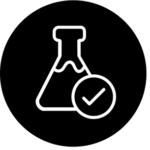SOLUTIONS
Advanced Diagnostics
Advanced molecular diagnostics offer unmatched accuracy, providing customized treatment options to address antibiotic resistance in STIs. Designed to meet the latest CDC STI treatment guidelines, these tests ensure the best possible care for patients.

Revolutionizing Care with
Molecular Diagnostics
The Growing STI Challenge
According to the World Health Organization, more than 1 million curable STIs are acquired every day. In 2020, there were an estimated 374 million new infections 1, including:
- Chlamydia trachomatis (129 million cases) 1
- Neisseria gonorrhoeae (82 million cases) 1
- Trichomonas vaginalis (156 million cases) 1
- Mycoplasma genitalium (MG)
These infections not only increase the risk of HIV transmission but also contribute to antimicrobial resistance (AMR). If left untreated, they can lead to severe health complications such as cervicitis, urethritis, pelvic inflammatory disease (PID), and pregnancy-related issues, underscoring the need for timely and accurate treatment.

The Rising Challenge of Antimicrobial Resistance
The treatment of sexually transmitted infections (STIs) is becoming increasingly difficult as pathogens evolve resistance to commonly prescribed antibiotics. Antimicrobial resistance (AMR) is a global health threat, contributing to:
Globally, antibiotic resistance in Neisseria gonorrhoeae and Mycoplasma genitalium is particularly concerning:
As resistant strains become more prevalent, access to molecular-based antimicrobial resistance testing is critical to guiding effective treatment options. The CDC stresses the importance of this testing to combat AMR and ensure patients receive the most effective therapies.

Resistance Testing: A Cornerstone of Modern Healthcare

GyrA Testing for Neisseria Gonorrhoeae

23S rRNA Testing for Mycoplasma Genitalium

Resistance Testing:
A Cornerstone of Modern Healthcare
Resistance testing is a critical tool in modern healthcare, enabling precise treatment by identifying which antimicrobial drugs remain effective against specific pathogens, including resistant strains of Neisseria gonorrhoeae and Mycoplasma genitalium. By revealing the resistance profile of pathogens, clinicians can tailor therapies for better outcomes, reducing treatment failures and improving patient care. Resistance testing also plays a pivotal role in combating antimicrobial resistance by promoting the careful use of antibiotics, which is essential in addressing this growing healthcare challenge and ensuring that patients receive the most effective treatments available.
Understanding the genetic mutations driving resistance in Neisseria gonorrhoeae and Mycoplasma genitalium is crucial for enhancing treatment strategies. By prioritizing resistance testing, we empower clinicians to tailor therapies that not only reduce the risk of resistance development but also significantly improve patient outcomes.

GyrA Testing for
Neisseria Gonorrhoeae
The gyrase A (gyrA) test detects mutations in the gyrA gene, particularly at position S91, which indicates resistance to ciprofloxacin. Identifying this mutation allows healthcare providers to preserve first-line treatments, such as ceftriaxone, for resistant cases while using ciprofloxacin for susceptible infections. The molecular-based resistance testing differentiates between the susceptible wild-type S91 and the resistant S91F mutation, guiding targeted treatment. The gyrA S91F mutation is a point mutation in the gyrA gene of DNA gyrase that serves as a strong indicator of ciprofloxacin resistance in Neisseria gonorrhoeae and is sufficient to confer resistance 6, 7, 8. Additionally, other mutations that have been associated with elevated ciprofloxacin minimum inhibitory concentrations (MICs) include a mutation at D95 in gyrA gene and mutations in the topoisomerase IV parC gene.


23S rRNA Testing for
Mycoplasma Genitalium
Macrolide resistance in Mycoplasma genitalium is primarily caused by mutations in the 23S rRNA gene. These mutations alter the ribosomal binding site for macrolides, such as azithromycin, inhibiting the antibiotics’ ability to interfere with protein synthesis. Resistance testing for the 23S rRNA gene is essential for identifying mutations associated with resistance to macrolide antibiotics. This molecular-based resistance testing focuses on detecting specific mutations at positions 2058 and 2059, such as (A2058C, A2058G, A2058T, A2059C, A2059G), which are strongly associated with resistance to macrolide antibiotics 9, 10. Detecting specific mutations enables clinicians to select the most effective antibiotics for MG infections, such as moxifloxacin for macrolide-resistant strains.
References:
[1] World Health Organization. (2020). Sexually transmitted infections (STIs) https://www.who.int/news-room/fact-sheets/detail/sexually-transmitted-infections-(stis)
[2] World Health Organization. (2019). Antimicrobial resistance https://www.who.int/news-room/fact-sheets/detail/antimicrobial-resistance
[3] Centers for Disease Control and Prevention (CDC). (2019) AR Threats Report https://www.cdc.gov/antimicrobial-resistance/data-research/threats/index.html
[4] World Health Organization (2021) Gonorrhoea https://www.who.int/news/item/22-11-2021-gonorrhoea-antimicrobial-resistance-results-and-guidaNce-vaccine-development
[5] Centers for Disease Control and Prevention (CDC). (2021) Mycoplasma genitalium https://www.cdc.gov/std/treatment-guidelines/mycoplasmagenitalium.htm
[6] Allan-Blitz LT, Wang X, Klausner JD. Wild-Type Gyrase A Genotype of Neisseria gonorrhoeae Predicts In Vitro Susceptibility to Ciprofloxacin: A Systematic Review of the Literature and Meta-Analysis. Sex Transm Dis. 2017 May;44(5):261-265. doi: 10.1097/OLQ.0000000000000591. PMID: 28407640; PMCID: PMC5407314. https://pmc.ncbi.nlm.nih.gov/articles/PMC5407314/
[7] Unemo M, Shafer WM. Antimicrobial resistance in Neisseria gonorrhoeae in the 21st century: past, evolution, and future. Clin Microbiol Rev. 2014 Jul;27(3):587-613. doi: 10.1128/CMR.00010-14. PMID: 24982323; PMCID: PMC4135894. https://pubmed.ncbi.nlm.nih.gov/24982323/
[8] Low N, Unemo M. Molecular tests for the detection of antimicrobial resistant Neisseria gonorrhoeae: when, where, and how to use? Curr Opin Infect Dis. 2016 Feb;29(1):45-51. doi: 10.1097/QCO.0000000000000230. PMID: 26658656. https://pubmed.ncbi.nlm.nih.gov/26658656/
[9] R. H. T. Nijhuis, T. T. Severs, D. S. J. M. Van der Vegt, A. A. Van Zwet, J. G. Kusters, High levels of macrolide resistance-associated mutations in Mycoplasma genitalium warrant antibiotic susceptibility-guided treatment, Journal of Antimicrobial Chemotherapy, Volume 70, Issue 9, September 2015, Pages 2515–2518, https://doi.org/10.1093/jac/dkv136
[10] Jensen JS, Bradshaw C. Management of Mycoplasma genitalium infections – can we hit a moving target? BMC Infect Dis. 2015 Aug 19;15:343. doi: 10.1186/s12879-015-1041-6. PMID: 26286546; PMCID: PMC4545773. https://pubmed.ncbi.nlm.nih.gov/26286546/
